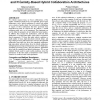Free Online Productivity Tools
i2Speak
i2Symbol
i2OCR
iTex2Img
iWeb2Print
iWeb2Shot
i2Type
iPdf2Split
iPdf2Merge
i2Bopomofo
i2Arabic
i2Style
i2Image
i2PDF
iLatex2Rtf
Sci2ools
CSCW
2006
ACM
2006
ACM
Response times in N-user replicated, centralized, and proximity-based hybrid collaboration architectures
We evaluate response times, in N-user collaborations, of the popular centralized (client-server) and replicated (peer-to-peer) architectures, and a hybrid architecture in which each replica serves a cluster of nearby clients. Our work consists of definitions of aspects of these architectures that have previously been unspecified but must be resolved for the analysis, a formal evaluation model, and a set of experiments. The experiments are used to define the parameters of and validate the formal analysis. In addition, they compare the performances, under the three architectures, of existing data-centric, logic-centric, and stateless shared components. We show that under realistic conditions, a small number of users, high intra-cluster network delays, and large output processing and transmission costs favor the replicated architecture, large input size favors the centralized architecture, high inter-cluster network delays favor the hybrid architecture, and high input processing and tran...
| Added | 13 Jun 2010 |
| Updated | 13 Jun 2010 |
| Type | Conference |
| Year | 2006 |
| Where | CSCW |
| Authors | Sasa Junuzovic, Prasun Dewan |
Comments (0)

